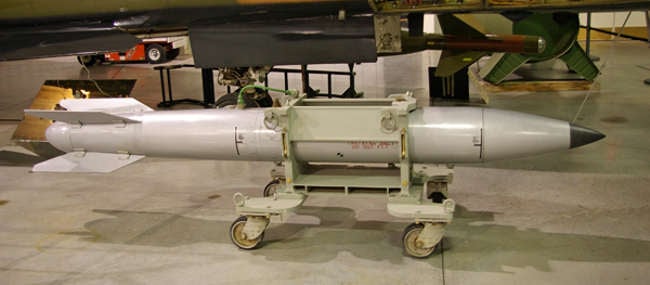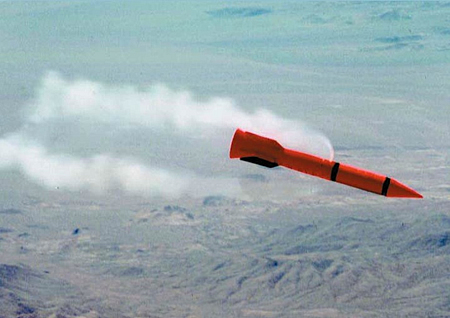Dangerous Crossroads: Is America Considering the Use of Nuclear Weapons against Libya?
Global Research, April 7, 2011
The B-2 Spirit Stealth bomber is the “chosen carrier” of the B61 -11 nuclear bombs. The B-2 Spirit Stealth bomber out of Whiteman Air Force Base in Missouri was not only sent on a mission to bomb Libya at the very outset of the air campaign, it was subsequently used in the testing of the B61 Mod 11 nuclear bomb.
The B61-11 has a yield of two thirds of a Hiroshima bomb. Why were these tests of the equipment and functionality of a tactical nuclear weapon scheduled shortly after the onset of the Libya bombing campaign? Why now?
Is the timing of these tests coincidental or are they in any way related to the chronology of the Libya bombing campaign?
U.S. Air Force Global Strike Command, which is responsible for the coordination of US bombing operations directed against Libya was also involved in the testing of the B61-11 nuclear bombs.
Both the bombing of Libya by the B-2 Spirit Stealth bomber (see image above) on March 19-20, as well as the testing of the functionality of the B61-11 nuclar bomb (announced April 4) were implemented out of the same US Air Force base in Missouri.
An earlier article entitled America’s Planed Nuclear Attack on Libya, (PART I) provided details of the Pentagon’s plan under the Clinton administration to wage a nuclear attack on Libya.
 |
America’s Planned Nuclear Attack on Libya PART I
- by Prof. Michel Chossudovsky – 2011-03-30
|
Thinking the Unthinkable. The Pentagon’s Plan to Nuke Libya
|
The Pentagon had envisaged the use of the B61 Mod 11 nuclear bomb against Libya. Categorized as a mini-nuke, the B61-11 is a 10 kiloton bomb with a yield equivalent to two thirds of a Hiroshima bomb. (See Michel Chossudovsky, America’s Planed Nuclear Attack on Libya, Global Research, March 25, 2011)
The Pentagon’s 1996 plan to nuke Libya had been announced in no uncertain terms at a press briefing by Assistant Secretary of Defense Harold P. Smith:
“[The] Air Force would use the B61-11 [nuclear weapon] against Libya’s alleged underground chemical weapons plant at Tarhunah if the President decided that the plant had to be destroyed. ‘We could not take [Tarhunah] out of commission using strictly conventional weapons,’ Smith told the Associated Press. The B61-11 ‘would be the nuclear weapon of choice,’ he told Jane Defence Weekly. (The Nuclear Information Project: the B61-11)
Clinton’s Defense Secretary William Perry –who was present at the press briefing– had earlier told a Senate Foreign Relations Committee that “the U.S. retained the option of using nuclear weapons against countries [e.g. Libya] armed with chemical and biological weapons.”(Ibid, See also Greg Mello, The Birth Of a New Bomb; Shades of Dr. Strangelove! Will We Learn to Love the B61-11? The Washington Post, June 01, 1997)
The Department of Defense’s objective was to fast track the “testing” of the B61-11 nuclear bomb on an actual country and that country was Libya:
“Even before the B61 came on line, Libya was identified as a potential target”. (Bulletin of the Atomic Scientists – September/ October 1997, p. 27). (For further details see Michel Chossudovsky, America’s Planned Nuclear Attack on Libya, March 2011)
While the 1996 plan to bomb Libya using tactical nuclear weapons was subsequently shelved, Libya was not removed from the “black list”: “The Qadhafi regime” remains to this date a target country for a pre-emptive (“defensive”) nuclear attack.
As revealed by William Arkin in early 2002, “The Bush administration, in a secret policy review… [had] ordered the Pentagon to draft contingency plans for the use of nuclear weapons against at least seven countries, naming not only Russia and the “axis of evil” Iraq, Iran, and North Korea but also China, Libya and Syria. (See William Arkin, “Thinking the Unthinkable”, Los Angeles Times, 9 March 2002).
According to the 2001 Nuclear Posture Review, adopted by the Senate in 2002, Libya is on the “Pentagon’s list”. Moreover, it is also important to emphasize that Libya was the first country to be tagged and formally identified (at a Department of Defense press briefing) as a possible target for a US sponsored nuclear attack using the B61 Mod 11 nuclear bomb. This announcement was made in 1996, five years prior to the formulation of the pre-emptive nuclear war doctrine under the Bush administration (i.e the 2001 Nuclear Posture Review).
The Testing of the B61-11 Nuclear Bomb (Announced on April 4, 2011)
What is the relevance of the history of the B61-11 nuclear bomb and earlier threats directed by the Clinton administration against Libya?
Has the project to nuke Libya been shelved or is Libya still being contemplated as a potential target for a nuclear attack?
Shortly after the commencement of the Libya bombing campaign on March 19, the US Department of Defense ordered the testing of the B61-11 nuclear bomb. These tests pertained to the installed equipment and weapon ‘s components of the nuclear bomb.
The announcement of these tests was made public on April 4; the precise date of the test was not revealed, but one can reasonably assume that it was in the days prior to the April 4 press release by the National Nuclear Security Administration (NNSA. Press Release, NNSA Conducts Successful B61-11 JTA Flight Test, Apr 4, 2011,)
The B-2 Spirit Stealth bomber is the US Air Force’s chosen “carrier” for the delivery of the B61 Mod 11 nuclear bomb. In late March or early April (prior to April 4), the B-2 Spirit Stealth bomber from the 509th Bomber Wing operating out of Whiteman Air Force Base, was used in the so-called “Joint Test Assembly” (JTA) of the B61 Mod 11 nuclear bomb.
In other words, the B61-11 was tested using the same B-2 Spirit Stealth bombers out of Whiteman Air Force Base, which were used to bomb Libya at the very outset of the air campaign.


B61-11 Simulation
The Joint Test Assembly (JTA) of the B61-11
This JTA testing was undertaken by the National Nuclear Security Administration (NNSA) together with the U.S. Air Force Global Strike Command, which coincidentally is responsible for the coordination of US bombing operations directed against Libya as well as ongoing operations in Iraq and Afghanistan.
“The JTA was produced by the NNSA in support of the Joint Surveillance Flight Test Program between the Department of Defense and the NNSA” (Press release, op cit)
The Joint Test Assembly (JTA) in the case of the B61 Mod 11 nuclear bomb, requires testing the equipment of the B61-11 using a proxy conventional non-nuclear warhead. Essentially what is involved is to test all the installed equipment on the nuclear bomb and ensure its functionality without actually having a nuclear explosion. The JTA test “was built to simulate the actual B61-11 weapon configuration utilizing as much war reserve hardware as feasible. It was assembled at the Pantex plant in Amarillo, Texas and was not capable of nuclear yield, as it contained no special nuclear materials.” (Press Release, NNSA Conducts Successful B61-11 JTA Flight Test, Apr 4, 2011)
“JTA tests [are to ensure] that all weapon systems [e.g. B61-11 nuclear bomb] perform as planned and that systems are designed to be safe, secure and effective,”…. A JTA contains instrumentation and sensors that monitor the performance of numerous weapon components [e.g of the B61-11] during the flight test to determine if the weapon functions as designed. This JTA also included a flight recorder that stored the bomb performance data for the entire test. The data is used in a reliability model, developed by Sandia National Laboratories, to evaluate the reliability of the bomb. (Ibid)
Read more here: http://waronyou.com/topics/dangerous-crossroads-is-america-consider...!+Mail
"Destroying the New World Order"
THANK YOU FOR SUPPORTING THE SITE!
Latest Activity
- Top News
- ·
- Everything
entitlement
'They’re Waiting for Us to Die': Area 51 Veterans Plead for Trump’s Help | Elizabeth Vargas Reports
I joined Facebook after 5 years of suspension!!! It went as expected.
Who Were the Silver Ghosts and Fork Tailed Devils Over Germany in WWII?
THE GREAT FLOOD Official Trailer (2026) Netflix | Global Disaster Movies 4K
Mothman Prophecies
The 100 Series Designated for SAC and a Possible WWIII
© 2025 Created by truth.
Powered by
![]()
You need to be a member of 12160 Social Network to add comments!
Join 12160 Social Network